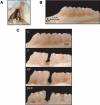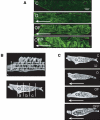Cytokine expression and accelerated tooth movement
- PMID: 20639508
- PMCID: PMC3318047
- DOI: 10.1177/0022034510373764
Cytokine expression and accelerated tooth movement
Abstract
It has been shown that inhibiting the expression of certain cytokines decreases the rate of tooth movement. Here, we hypothesized that stimulating the expression of inflammatory cytokines, through small perforations of cortical bone, increases the rate of bone remodeling and tooth movement. Forty-eight rats were divided into 4 groups: 50-cN force applied to the maxillary first molar (O), force application plus soft tissue flap (OF), force application plus flap plus 3 small perforations of the cortical plate (OFP), and a control group (C). From the 92 cytokines studied, the expression of 37 cytokines increased significantly in all experimental groups, with 21 cytokines showing the highest levels in the OFP group. After 28 days, micro-computed tomography, light and fluorescent microscopy, and immunohistochemistry demonstrated higher numbers of osteoclasts and bone remodeling activity in the OFP group, accompanied by generalized osteoporosity and increased rate of tooth movement.
Figures




References
-
- Adachi Y, Okazaki M, Ohno N, Yadomae T. (1994). Enhancement of cytokine production by macrophages stimulated with (1-->3)-beta-D-glucan, grifolan (GRN), isolated from Grifola frondosa. Biol Pharm Bull 17:1554-1560 - PubMed
-
- Alhashimi N, Frithiof L, Brudvik P, Bakhiet M. (2000). Orthodontic movement induces high numbers of cells expressing IFN-gamma at mRNA and protein levels. J Interferon Cytokine Res 20:7-12 - PubMed
-
- Arend WP, Palmer G, Gabay C. (2008). IL-1, IL-18, and IL-33 families of cytokines. Immunol Rev 223:20-38 - PubMed
-
- Arias OR, Marquez-Orozco MC. (2006). Aspirin, acetaminophen, and ibuprofen: their effects on orthodontic tooth movement. Am J Orthod Dentofacial Orthop 130:364-370 - PubMed
-
- Başaran G, Ozer T, Kaya FA, Hamamci O. (2006). Interleukins 2, 6, and 8 levels in human gingival sulcus during orthodontic treatment. Am J Orthod Dentofacial Orthop 130:E1-6 - PubMed
Publication types
MeSH terms
Substances
Grants and funding
LinkOut - more resources
Full Text Sources
Other Literature Sources
Medical
Research Materials

